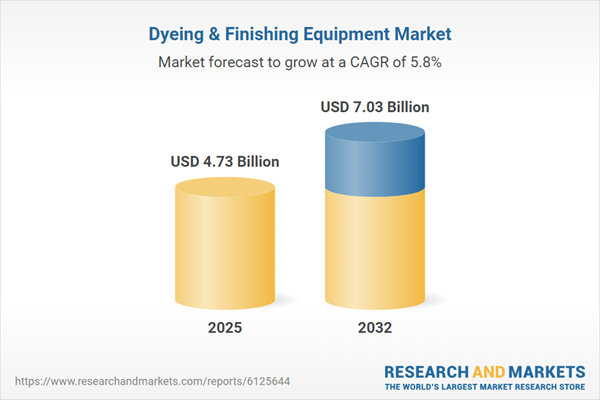Speak directly to the analyst to clarify any post sales queries you may have.
The global dyeing and finishing equipment market is advancing rapidly, shaped by demands for sustainable practices, digital transformation, and competitive differentiation. Senior leaders in the textile value chain are prioritizing technology upgrades and new business models to drive operational performance while meeting regulatory and customer expectations.
Market Snapshot: Dyeing and Finishing Equipment Market Overview
The dyeing and finishing equipment market grew from USD 4.48 billion in 2024 to USD 4.73 billion in 2025. It is expected to continue growing at a CAGR of 5.79%, reaching USD 7.03 billion by 2032. Market growth is driven by major shifts toward digitalization, increased automation, and a heightened focus on reducing environmental impacts. The market's expansion highlights the critical need for advanced, adaptable solutions capable of supporting both legacy operations and modern greenfield facilities worldwide.
Dyeing & Finishing Equipment Market Scope and Segmentation
- Machine Types: Beam dyeing machines, jet dyeing machines, jigger dyeing machines, soft flow dyeing machines, winch dyeing machines, calendering machines, coating and laminating machines, compacting machines, heat setting machines, raising machines, sanforizing machines, stenter machines
- Operation Modes: Batch processing equipment, continuous processing equipment
- Fabric Types: Blended fabrics, natural fibers (cotton, silk, wool), synthetic fibers (acrylic, nylon, polyester)
- End Users: Apparel and garment manufacturers, dye houses, textile mills
- Distribution Channels: Offline channels, online platforms
- Regional Breakdown: Americas (United States, Canada, Mexico, Brazil, Argentina, Chile, Colombia, Peru), Europe, Middle East & Africa (United Kingdom, Germany, France, Russia, Italy, Spain, Netherlands, Sweden, Poland, Switzerland, United Arab Emirates, Saudi Arabia, Qatar, Turkey, Israel, South Africa, Nigeria, Egypt, Kenya), Asia-Pacific (China, India, Japan, Australia, South Korea, Indonesia, Thailand, Malaysia, Singapore, Taiwan)
- Featured Companies: A.T.E. Private Limited., A. Monforts Textilmaschinen GmbH & Co. KG, Beltecno Corporation, Benninger AG, Biancalani Srl, BRAZZOLI S.r.l., Brückner Textile Technologies GmbH & Co. KG, COSMOTEX, DMS Dilmenler Makina ve Tekstil San. Tic. A.Ş., Futai Machinery Co., Ltd., He'nan Xinxiang Lianda Textile Co., Ltd., Kusters Calico Machinery Pvt Ltd, Lafer S.p.A., Loris Bellini Srl, Morrison Textile Machinery Co., Murata Machinery, Ltd., Santex Rimar Group, SCLAVOS S.A., Then Maschinen GmbH, Thies GmbH & Co. KG, Tonello S.r.l.
Key Takeaways for Senior Decision-Makers
- Sustainability requirements are now central in equipment selection, with innovations focusing on energy efficiency and reduced chemical usage.
- Industry 4.0 integration is transforming textile operations, supporting process transparency, predictive maintenance, and seamless data-driven optimization.
- Segment-specific solutions such as modular designs and plug-and-play accessories are enabling rapid adaptation to changing production needs and materials.
- Strategic partnerships between equipment providers, chemical suppliers, and technology firms are accelerating new product development and broadening service models.
- Service excellence is a growing differentiator, with aftermarket offerings like predictive maintenance and remote diagnostics shaping long-term customer value.
- Regional market variations demand localized compliance expertise and tailored go-to-market strategies, especially in areas with evolving regulatory landscapes.
Tariff Impact: Navigating Cost Pressures in 2025
The imposition of new United States tariffs has prompted equipment manufacturers to reconsider sourcing and production configurations, giving rise to more domestic investment and collaborative distribution models. Suppliers are redesigning products to minimize exposure to restricted components, while end users seek stable maintenance agreements to manage financial unpredictability. Flexibility in procurement, along with strategic inventory and supply chain planning, is essential for mitigating ongoing policy risks.
Methodology & Data Sources
This report integrates primary interviews with equipment OEMs, textile producers, and regulatory advisors alongside analysis of industry databases, peer-reviewed research, and quantitative modeling. Scenario-based planning and sensitivity analyses ensure findings are grounded in realistic market assumptions and provide actionable guidance for stakeholders.
Why This Report Matters: Strategic Value for Senior Executives
- Enables informed investment by mapping out transformative technologies and emerging service trends.
- Supports risk mitigation through detailed analysis of regulatory, policy, and supply chain shifts.
Decision-makers gain an objective, comprehensive understanding of how evolving technologies and regional factors will shape long-term market opportunities and competitive dynamics.
Conclusion
The dyeing and finishing equipment market is undergoing significant transformation, driven by a convergence of sustainability, digital, and regulatory forces. Executives equipped with strategic insights from this report will be prepared to lead their organizations through ongoing industry evolution.
Table of Contents
3. Executive Summary
4. Market Overview
7. Cumulative Impact of Artificial Intelligence 2025
Companies Mentioned
The companies profiled in this Dyeing & Finishing Equipment market report include:- A.T.E. Private Limited.
- A. Monforts Textilmaschinen GmbH & Co. KG
- Beltecno Corporation
- Benninger AG
- Biancalani Srl
- BRAZZOLI S.r.l.
- Brückner Textile Technologies GmbH & Co. KG
- COSMOTEX
- DMS Dilmenler Makina ve Tekstil San. Tic. A.Ş.
- Futai Machinery Co., Ltd.
- He'nan Xinxiang Lianda Textile Co., Ltd.
- Kusters Calico Machinery Pvt Ltd
- Lafer S.p.A.
- Loris Bellini Srl
- Morrison Textile Machinery Co.
- Murata Machinery, Ltd.
- Santex Rimar Group
- SCLAVOS S.A.
- Then Maschinen GmbH
- Thies GmbH & Co. KG
- Tonello S.r.l.
Table Information
| Report Attribute | Details |
|---|---|
| No. of Pages | 190 |
| Published | November 2025 |
| Forecast Period | 2025 - 2032 |
| Estimated Market Value ( USD | $ 4.73 Billion |
| Forecasted Market Value ( USD | $ 7.03 Billion |
| Compound Annual Growth Rate | 5.7% |
| Regions Covered | Global |
| No. of Companies Mentioned | 22 |









